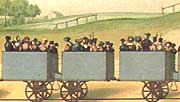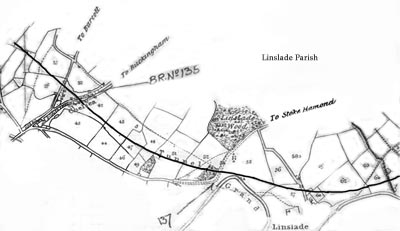| Royalty and the Railway | ||||||||||||||||
| The Dowager Queen Adelaide first used the Railway in 1842 and the London and Birmingham railway built a four wheeled carriage for her. It was a grand rail version of a royal horse drawn coach, it even had a bed! |  |
|||||||||||||||
 |
Queen Victoria became a regular railway traveller. On one of her earlier trips on the London and Birmingham line the company provided a four wheeled carriage which was centrally heated. Inside the saloon, was a throne like armchair upon which the Queen sat when in public and a more comfortable sofa hidden behind curtains for use when travelling. The roof was domed and on the roof the central ventilator outlet was disguised as a royal crown. | |||||||||||||||
| The 1844 Railway Act | ||||||||||||||||
 |
||||||||||||||||
| Although royalty travelled in some style, the commoners travelled, for the most part, in extreme discomfort. The sides of the carriages were open and did not provide any protection from the weather or pollution, although they did have holes drilled in the floor to allow rainwater to drain away. | ||||||||||||||||
| Third Class Passenger Carriages | ||||||||||||||||
| In fact, it wasn't unheard of for third class passengers to die probably from exposure, whilst making a journey by train, prior to the 1844 Railway Act. This Act decreed that each Railway Company must run one passenger train a day along a length of their line at the cheap rate of one penny per mile. The carriages on the train had to be provided with seats and protected from the weather. This legislation resulted in a considerable improvement in the quality and availability of third class rail travel. This Act was proposed by William Gladstone. The third class carriages were painted a distinctive uniform blue. | ||||||||||||||||
| Impact of the Railway on Linslade | ||||||||||||||||
| Prior to the railway arriving in Linslade there were very few dwellings on the site beyond the River Ouse. There were a few houses on Old Road, Soulbury Road and Stoke Road. The 1841 census shows us that the railway was beginning to have an impact on Linslade but as yet most inhabitants were still employed in agriculture. The population of Linslade and Leighton Buzzard in 1831 was 3330 and by 1841 had increased to 3965 (almost 20% in ten years). |
||||||||||||||||
 |
||||||||||||||||
| 1831 Census Map | ||||||||||||||||
| The London and Birmingham Railway merged on the 1st January 1846 with the Grand Junction Railway and the Birmingham and Manchester to become the London and North Western Railway (LNWR), creating 247 miles of railway. | ||||||||||||||||
 |
||||||||||||||||